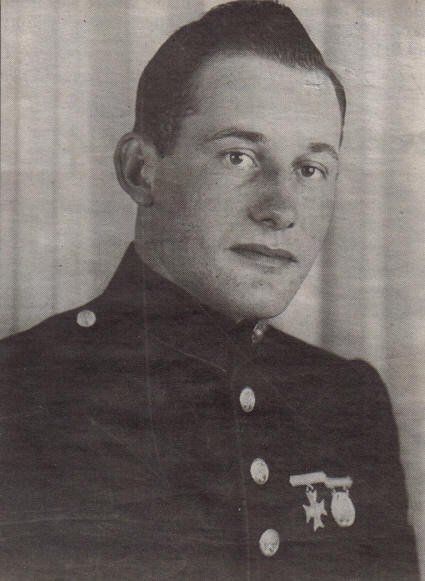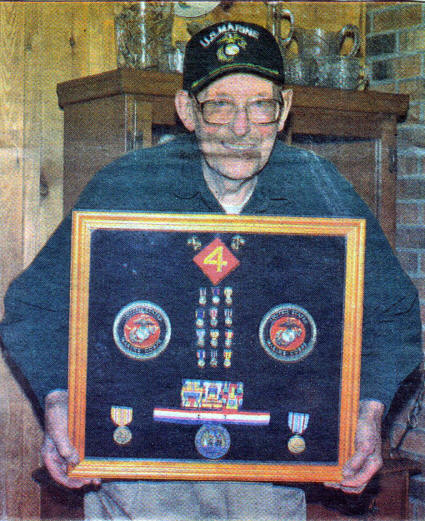Contact: Dolores (Mohr) Kenyon
E-mail: dolores@wiclarkcountyhistory.org
Surnames: Lipscy, Roosevelt, Luepke, Campbell, Washabaugh, Sturtz, Arnold
----Source: Clark County Press (Neillsville, Clark Co, WI) 10/27/2014
Lipscy, Don (Service Recognition - 3 November 2014)
Neillsville American Legion Honors Don Lipscy

Don Lipscy enlisted in the Marines in July 1943.
He served his country as a member of Company D, 2nd Battalion,
4th Marines Division (Contributed Photo)
By Todd Schmidt
The Neillsville American Legion Post 73 will be recognizing Don Lipscy for his military service at a special function Monday, Nov. 3, at the Legion Club.
Lipscy, 88, and his wife Hilda reminisced Thursday at their cozy Snyder Lake home about his time in the Marines and what his served to this country meant to him.
Lipscy was a native of St. Peter, MN. He enlisted in the Marines at the tender age of 17, after writing to President Roosevelt and the War Department with concerns about the government not continuing to accept any more recruits. In just 1943, Lipscy’s enlistment was processed in Minneapolis. His fingerprinting and paperwork had to be handled twice, as his name was mixed up with a recruit by the name of Don Luepke the first time around.
Lipscy was shipped out to 12 weeks of boot camp in San Diego as a member of Company D, 2nd Battalion, 4th Marines Division. He said the conditioning drills weren’t too rigorous for him.
“We lived almost three miles out of town, and I walked to work at a dairy in town,” Lipscy said. “That kept me in pretty good shape. We spent three weeks on the M-1 rifle and did a helluva lot of marching.”
According to Lipscy, The military reneged on a promised leave and sent the troops straight to Camp Elliot, CA, and then to Camp Pendleton, CA, where the 15,000 men in the division shipped out Jan. 13, 1944.
The men spent time on several different ships. While serving guard duty, Lipscy got seasick like many of his fellow Marines. “I was sick for five days,” Lipscy said. “For a while, I just laid down on the steel deck. I swore I would never get seasick again, and I didn’t.”
They sailed for 2,332 miles to Camp Maui in Hawaii, followed by 2,519 miles to the Marshall Islands. Then it was on to Saipan, the Tinian Islands and Iwo Jima.
“We were the first ones to leave the states and face combat right away,” Lipscy said. “We took Japanese-mandated property and territory in the Pacific and secured some of our objectives in a very short time.”
Things got rougher in a short time. Combat correspondent and medical officers John Campbell documented conditions on Saipan.
Campbell wrote: “Beware of sharks, barracuda, sea snakes, anemones, razor sharp coral, polluted waters, poison fish, giant clams that shut on a solder like a bear trap. Once ashore, beware of leprosy, typhoid, filariasis, yaws, dengue fever, dysentery, saber grass, insects, snakes and giant lizards. Eat nothing growing on the island. Don’t drink the water and don’t approach the inhabitants.”
For a few days, warships raked the beachhead and shelled Aslito Airfield. Carrier planes blasted fuel and ammo dumps, causing smoke to rise in towering columns.
At Saipan, Lipscy’s Company was the second of three waves of assault troops. Lipscy was a machine gunner and later a demolition man. Four men handled the 30-caliber machine gun system that fired 600 rounds per minutes.
“We lost an awful lot of men of Saipan” Lipscy said. “Many of the Japanese were afraid of the Marines. Some of them threw themselves over the cliffs onto the rocks below, kids first. It was suicide.”
Once on patrol, a Japanese soldier appeared out of a cave, raised his rifle and killed the man right behind Lipscy. In all, Lipscy’s unit sustained 17,700 casualties while overseas.
The unit spent about 10 days in the Tinian Islands. They returned to Maui to regroup before heading to Iwo Jima with the rest of the assault troops for what was supposed to be a two day battle.
The military needed to capture Iwo Jima for use as a B-29 bomber airbase. It was only 728 miles to Japan.
Lipscy said the beaches were made of loose and coarse volcanic ash. Men sank to their ankles, and jeeps sank to their hubcaps. For a time, tanks wallowed helplessly and were picked off by enemy guns. Trucks couldn’t operate at all.
“The wreckage was indescribable,” Lipscy said. “There was thick debris for about two miles.”
In all, Lipscy said an estimated 30,000 soldiers were killed from both sides.
Iwo Jima is a total of about seven square miles,” Lipscy noted. “Everywhere you looked there were dead people. For a while, all hell broke loose. They shot everything they had at us. Some of it was really big stuff.”
A 340mm shell hit near Lipscy’s patrol; one man had his arm blown off and another man was blinded.
According to the 4th Marine Division Journal, a document was taken from a Japanese pillbox wall and translated as follows: “Above all else, we shall dedicate ourselves and our entire strength to the defense of this island; we shall grasp bombs, charge the enemy tanks and destroy them; we shall infiltrate into the midst of the enemy and annihilate them; with every salvo, we will, without fail, kill the enemy; each man will make it his duty to kill 10 of the enemy before dying; until we are destroyed to the last man, we shall harass the enemy by guerilla tactics.”
All of the men received Purple Hearts. Lipscy is also proud of the medals he received from serving in Saipan and Iwo Jima. He also received two Presidential Citations and a Navy Commendation. Lipscy received his Honorable Discharge in November 1945.
During the height of the battle at Iwo Jima, a Seabee by the name of Vernon Washabaugh from Vernon, PA, jumped in Lipscy’s foxhole. “He looked like he was ready to die,” Lipscy said. “He told me I saved his life.”
Washabaugh looked for Lipscy for many years after the war. They found each other in 2006. The story appeared in local papers after a connection was made with a Pennsylvania friend of Howie Sturtz.
“They actually raised the American Flag at Iwo Jima twice when the battle was over,” Lipscy said. “I saw them raise it the first time. The guys that fought to get up there raised it the second time. All the shops were blowing their horns. That was the big one.”

Don Lipscy displays the medals and commendations he received for meritorious service from 1943-1945 as a member of Company D, 2nd Battalion, 4th Marines Division (Todd Schmidt/Clark County Press)
Upon returning to the states, Lipscy worked at the dairy for a while and then moved to the Standard Oil station in St. Peter. He then got a job as a brick foreman with L.G. Arnold of Eau Claire, working on Neillsville jobs including the hospital, High school and nursing home. L. G. Arnold also did the brick work of St. Bede’s Priory in Eau Claire.
Following his ‘retirement,’ Lipscy laid some of the stone at The Highground and cut out the Wisconsin pattern. He also built eight homes in the Snyder Lake area and was in charge of building the Masonic Lodge in Neillsville.
Lipscy also helped put the brick underneath the cannon at the new Legion site in Neillsville.
Lipscy is a member of the Masonic Lodge and Eastern Star. Eventually, the Neillsville Masonic Lodge combined with the Merrillan Masonic Lodge.
Lipscy is a member of the Neillsville American Legion, the Neillsville VFW and the Disabled American Veterans of Black River Falls Chapter No. 61.
He also likes to hunt and fish. He shot trap in his younger days and used to restore old cars. His last project was a 1987 blue Corvette that featured a wood grain dash.
Hilda and Don were married Aug. 9, 1947. She was taking nursing training at the state hospital in St. Peter. They have one son, Stephen, who lives next door with his wife Bonnie. The Lipscys have two grandchildren, Jacob and Rebecca, and five great-grandchildren, Michael, Brent, Andrew, Kaylee and Nolan.
Lipscy is a humble fellow who is not a big fan of being recognized for doing things. “I think you should do what you are supposed to do in life, and you shouldn’t get rewarded too much,” he said. “When you are at war, your mission is to kill as many of the enemy as you can. Today, if you kill an enemy soldier, they have a big investigation. I don’t agree with some of the things that go on now.”
Lipscy returned to Hawaii for the dedication of Marine Park. He received an invitation to attend the commission of the U. S. S. Iwo Jima, but was in the hospital and was unable to attend.
Lipscy went on the Let Freedom Ring Freedom Honor Flight June 19, 2010, which departed from La Crosse Airport to Washington, D. C., to visit the WWII Memorial. “I really enjoyed that trip,” Lipscy said. “I guess I’m satisfied with my service to the country. The men I served with believed in their country. It is a time in my life I will never forget.”
